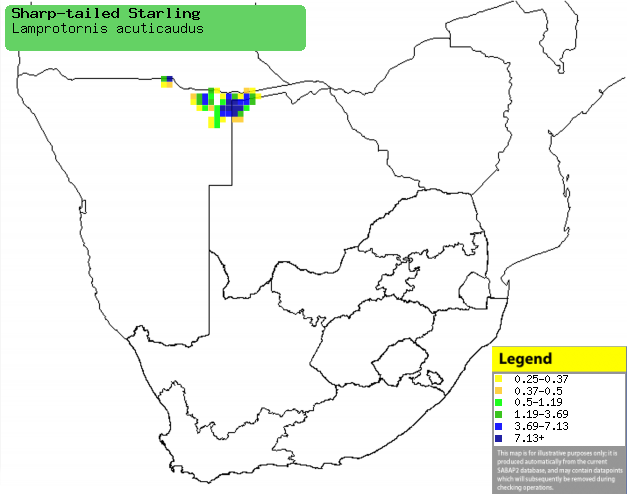|
Lamprotornis acuticaudus
(Sharp-tailed starling)
Spitsstertglansspreeu [Afrikaans]; Pijlstaart-glansspreeuw
[Dutch]; Choucador à queue fine [French]; Keilschwanz-glanzstar [German];
Estorninho-de-cauda-acuminada [Portuguese]
Life
> Eukaryotes >
Opisthokonta
> Metazoa (animals) >
Bilateria >
Deuterostomia > Chordata >
Craniata > Vertebrata (vertebrates) > Gnathostomata (jawed
vertebrates) > Teleostomi (teleost fish) > Osteichthyes (bony fish) > Class:
Sarcopterygii (lobe-finned
fish) > Stegocephalia (terrestrial
vertebrates) > Tetrapoda
(four-legged vertebrates) > Reptiliomorpha > Amniota >
Reptilia (reptiles) >
Romeriida > Diapsida > Archosauromorpha > Archosauria >
Dinosauria
(dinosaurs) > Saurischia > Theropoda (bipedal predatory dinosaurs) >
Coelurosauria > Maniraptora > Aves
(birds) >
Order: Passeriformes
> Family: Sturnidae
> Genus: Lamprotornis
Distribution and habitat
Occurs from south-western Tanzania through southern DRC to
Zambia and Angola, extending into southern Africa. Here it is localised and
uncommon in north-eastern Namibia and adjacent north-western Botswana, generally
preferring open woodland, especially miombo (Brachystegia) and Mopane (Colosphermum
mopane).
|
 |
|
Distribution of Sharp-tailed starling in southern Africa,
based on statistical smoothing of the records from first SA Bird Atlas
Project (©
Animal Demography unit, University of
Cape Town; smoothing by Birgit Erni and Francesca Little). Colours range
from dark blue (most common) through to yellow (least common). |
Food
It forages on the ground, feeding on insects and fruit,
such as Diospyros lycoides (Bluebush star-apple) and Diospyros kirkii
(Large-leaved jackal berry).
Breeding
- The nest is a platform built of hair, grass and feathers, typically placed
in a tree cavity.
- Egg-laying season is from August-October in Angola, so southern Africa's
laying dates are probably similar.
Threats
Status uncertain.
References
-
Hockey PAR, Dean WRJ and Ryan PG 2005. Roberts
- Birds of southern Africa, VIIth ed. The Trustees of the John Voelcker
Bird Book Fund, Cape Town.
|
